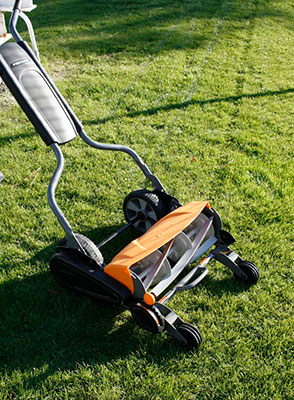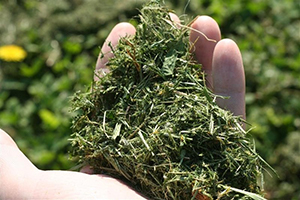Mowing Your Florida Lawn

Mowing is one of the most important aspects of maintaining a good quality lawn. Mowing increases turfgrass density, producing a tighter lawn that is resistant to weeds. Proper mowing practices, along with fertilization and irrigation, can largely determine the success or failure of a lawn.
The two main components of mowing are cutting height and frequency. Both of these factors depend on the turfgrass species, cultivar, and the level of lawn quality desired. Several other practices involving the use of mowers are also important in creating a quality lawn.
Height of Mowing
The optimum cutting height is determined by the growth habit and leaf width of the turfgrass species. A grass that spreads horizontally can usually be mowed shorter than an upright-growing, bunch-type grass. Grasses with narrow blades can generally be mowed closer than grasses with wide blades. Bermudagrass is mowed at very low heights because of its numerous narrow leaf blades and low growth habit. On the other hand, bahiagrass needs to be mowed at higher heights because of its open, upright growth habit.
Turfgrass undergoes physiological stress with each mowing event, particularly if too much leaf tissue is removed. Effects of “scalping,” or removal of too much shoot tissue at one time, can produce long-term damage to the turf. This can leave turf susceptible to other stresses such as insects, disease, drought, and sunscald. Mowing also greatly influences rooting depth, with development of a deeper root system in response to higher mowing heights. Advantages of the deeper root system are greater tolerances to drought, insects, disease, nematodes, temperature stress, poor soil conditions, nutrient deficiencies, and traffic. Mowing below the recommended heights for each species is a primary cause of turf death and should be avoided.
Frequency of Mowing
The growth rate of the lawn determines how frequently it needs to be mowed. The growth rate is influenced by grass species, weather conditions, time of year, and level of management. Slowest growth rates occur in the winter or under low fertility and irrigation, while fastest growth rates occur in the summer or under high fertility and watering practices.
Bermudagrass is a rapidly growing grass compared to zoysiagrass. Low-maintenance grasses like bahiagrass and centipedegrass are frequently mowed just to remove seedheads, rather than to cut leaf blades. Mow often enough so that no more than 1/3 of the blade height is removed per mowing. For example, if your St. Augustinegrass lawn is mowed at a height of 3 inches, it should be mowed when it grows to a height of 4 to 4 1/2 inches. Stress to the grass caused by mowing can be minimized by removing only a third of the leaf blade at each mowing. It is important to always leave as much leaf surface as possible so that photosynthesis can occur.
Using Your Grass Clippings

What do you do with your grass clippings? Grass clippings are a valuable energy source because they contain nutrients that plants need. When you mow your lawn, just let grass clippings remain on the grass. They’ll slowly break down on their own, saving you time and energy. Plus, you’ll reduce your fertilizer needs, since the decomposing clippings will add nutrients to your lawn. And as long as you mow on a regular basis, grass clippings left on the lawn will not contribute to the buildup of thatch.
Although many people believe that clippings contribute to thatch, research has shown that clippings are readily decomposed by microbial action. Thatch is the intermingled layer of already dead and decomposing organic matter on top of the soil and below the leaf blades. Excessive thatch can cause many problems for lawns, including poor water infiltration, increased insect and disease infestation, and poor turf quality. The tougher shoot components such as stems, rhizomes, and stolons are not easily degraded and do contribute to thatch.
Problems may also arise when turf is mowed infrequently and excess clippings (e.g., clumping) result. When this happens, clippings can be raked to distribute them more evenly.
If you don’t want to leave the grass clippings on the lawn, add them to your compost pile or use them as mulch for your landscape plants.
Mowing Equipment
Lawn mowers are available in a wide variety of sizes and styles with many features. The two basic types are the reel mower and the rotary mower. Variations of these include mulching, flail, and string mowers. Most mowers can be obtained as push or self-propelled models. Front, side, and rear-clipping discharge models are also available. The choice of mower often depends on personal preference. Points to consider when purchasing a mower are lawn size, turfgrass species, and level of lawn maintenance.
Rotary mowers are the most popular for home lawn maintenance because of their low cost, easy maneuverability, and simple maintenance. A large motor is required to horizontally turn the blade. The grass blade is cut on impact with the mower blade. Rotary mowers can pose a safety problem if improperly used. Most rotary mowers cannot mow lower than 1 inch and are best used for higher mowing heights. The blade needs to be sharpened and balanced frequently for the best possible cut.
Mulching mowers are modifications of rotary mowers. These are designed to cut leaf blades into very small pieces that decompose more quickly than leaf blades cut by conventional mowers. The mower blades are designed to create a mild vacuum in the mower deck until the leaf blades are cut into these small pieces. Mulching mowers do not have the traditional discharge chute like most rotary mowers.
Advantages of Mulching Mowers
- Clippings are returned to the turf where they will be decomposed very rapidly. This reduces yard waste and recycles nutrients to the turf.
- Mulching prevents yard waste from contributing to landfill overuse and eliminates clipping collection and disposal costs.
Disadvantages of Mulching Mowers:
- They are ineffective on wet or tall turf.
- Blades must be kept sharp.
- Current models are small and require higher horsepower.
Reel mowers are for highly maintained turf where appearance is important. Reel mowers cut with a scissorlike action to produce a very clean, even cut. They are used at cutting heights of 2 inches or less. The number of blades needed to produce a smooth, uniform cut will depend on the mowing height. Sharpening reel mowers is difficult and is best left to a professional mower repair service.
Flail mowers have numerous, loose-hanging small knives that are held out by centrifugal force as the shaft rotates at high speeds. The blades sever grass by impact. Flail mowers are used for low-maintenance utility sites that are cut infrequently. Mowing quality is inferior compared to a reel or rotary mower, and the time it takes to sharpen the many small blades limits flail mower use.
String mowers are similar to rotary mowers, except the blade is replaced with a monofilament line. This is a definite safety feature when operating the mower in some hard to mow areas such as hillsides or ditch banks. A high-speed motor is needed in these mowers to spin the line fast enough for a clean cut.
Good Mowing Practices
Follow these procedures and precautions for safe, good mowing:
- Pick up all stones, sticks and other debris before mowing to avoid damaging the mower or injuring someone with flying objects.
- Never mow wet turf with a rotary mower because clippings can clog the machine. Mow only when the turf is dry.
- Sharpen the mower blade frequently enough to prevent a ragged appearance to the turf
- Mow in a different direction every time the lawn is cut. This helps prevent wear patterns, reduces the grain (grass lying over in the same direction), and reduces the possibility of scalping
- Do not remove clippings. If clumping occurs, distribute these by remowing or by lightly raking. A leaf blower can also be used to distribute clippings.
- Check your mower every time it is used. Follow manufacturer’s recommendations for service and adjustments.
- Adjust cutting height by setting the mower on a driveway or sidewalk and using a ruler to measure the distance between the ground and the blade.
- Never fill a hot mower with gasoline.
- Always wear heavy leather shoes when mowing the lawn.
- Wash mower after use to reduce rusting and weed seed movement.
| Turfgrass Species | Optimal Mowing Height (inches) | Mowing Frequency (days) | Preferred Mower Type |
|---|---|---|---|
| Bahiagrass | 3.0-4.0 | 7-17 | Rotary/ flail |
| Bermudagrass | .5-1.5 | 3-5 | Reel |
| Carpetgrass | 1.5-2.0 | 10-14 | Rotary |
| Centipedegrass | 1.5-2.0 | 10-14 | Rotary/ reel |
| St. Augustinegrass | 2.5-4.0* | 5-14 | Rotary |
| Zoysiagrass | 1.0-3.0 | 10-14 | Reel |
| * Dwarf varieties of St. Augustinegrass (Seville, Jade, Palmetto, Delmar) are the only cultivars of this species that should be mowed at less than 3 | |||
Also on Gardening Solutions
This document is a reprint of Fact Sheet ENH 10, a series of the Environmental Horticulture Department, Florida Cooperative Extension Service, Institute of Food and Agricultural Sciences, University of Florida. First published: May 1991. Revised: January 2001. Please visit the EDIS website at http://edis.ifas.ufl.edu. Written by L.E. Trenholm, Assistant Professor, Turfgrass Specialist, Department of Environmental Horticulture, Institute of Food and Agricultural Sciences, University of Florida, Gainesville FL 32611, J.B. Unruh, Assistant Professor, Turfgrass Specialist, West Florida Research and Education Center, Institute of Food and Agricultural Sciences, Jay FL 32565, J.L. Cisar, Professor, Turfgrass Specialist, Ft. Lauderdale Research and Education Center, Institute of Food and Agricultural Sciences, University of Florida, Ft. Lauderdale FL 33314. The Institute of Food and Agricultural Sciences (IFAS) is an Equal Opportunity Institution.
